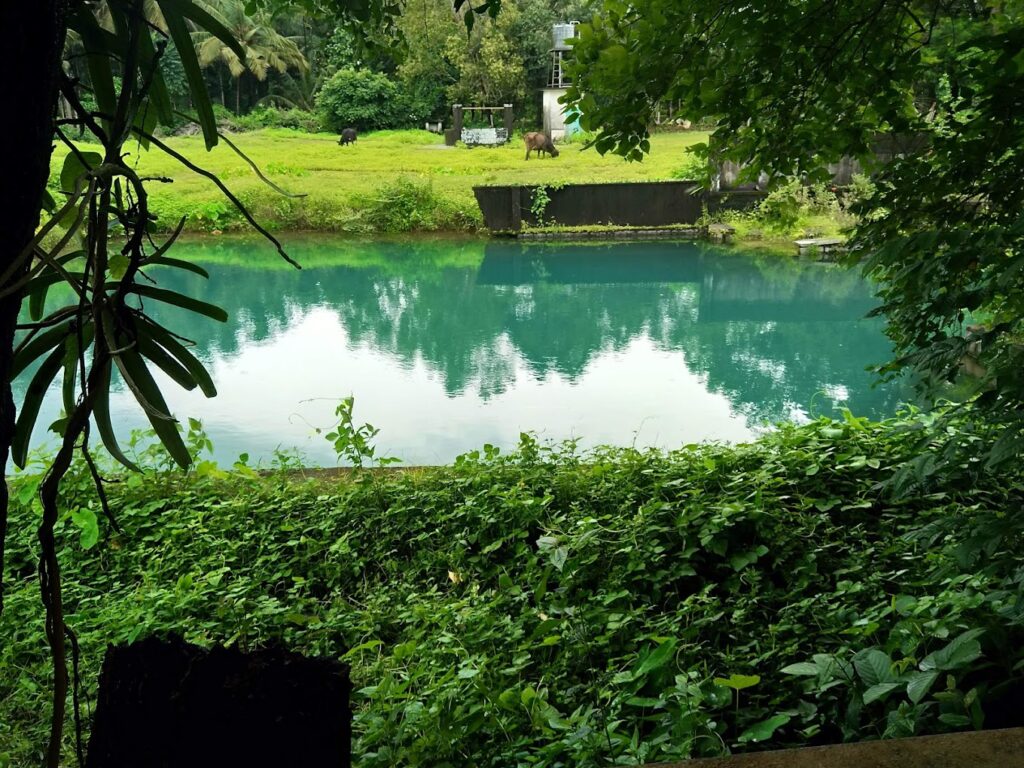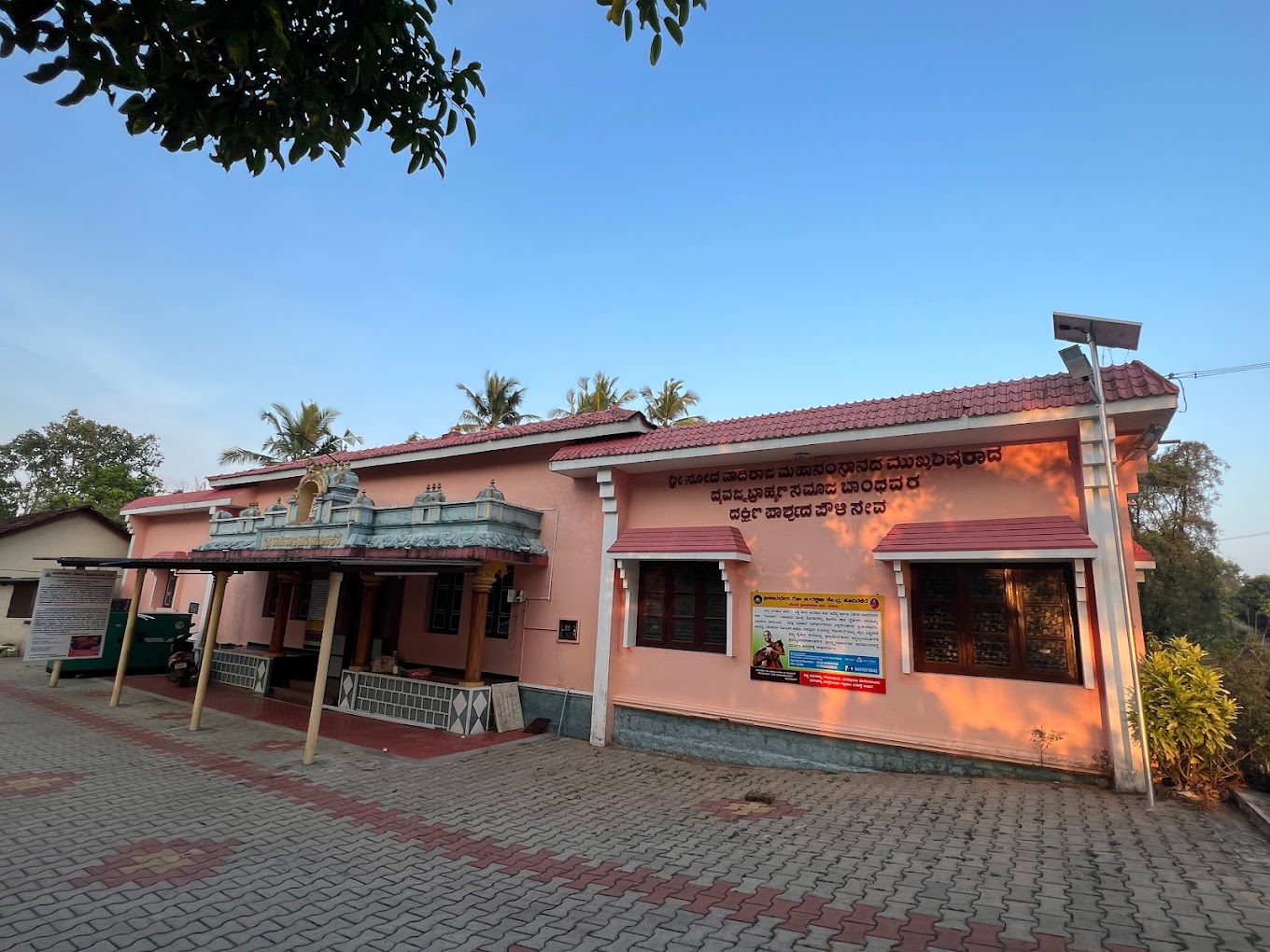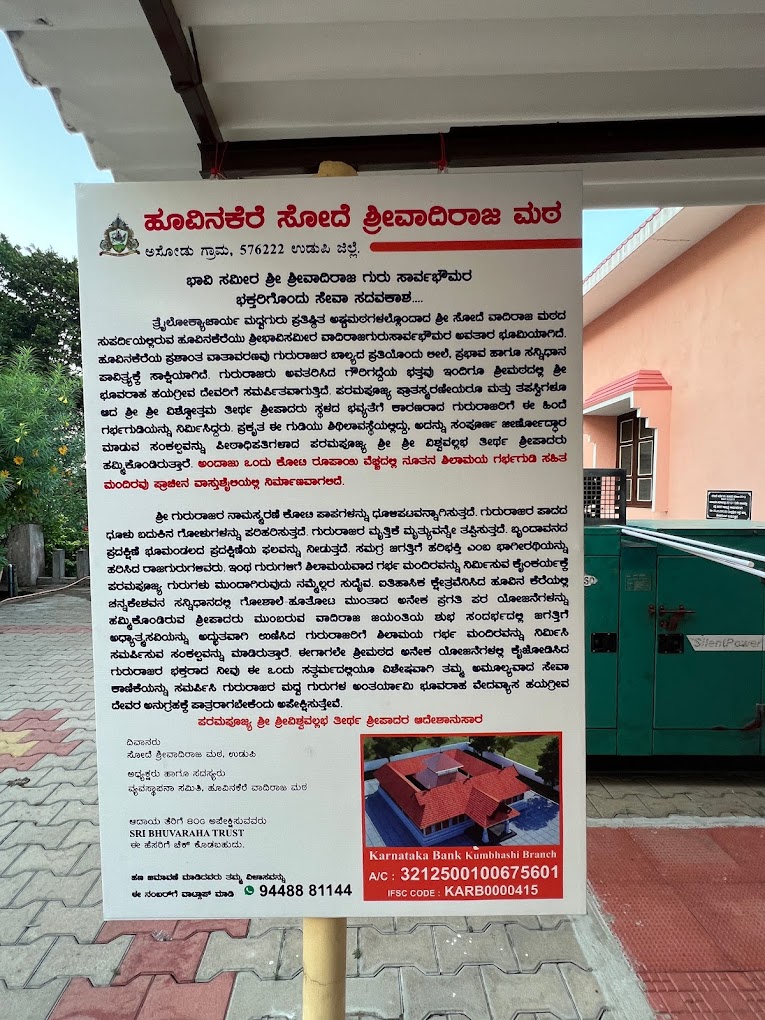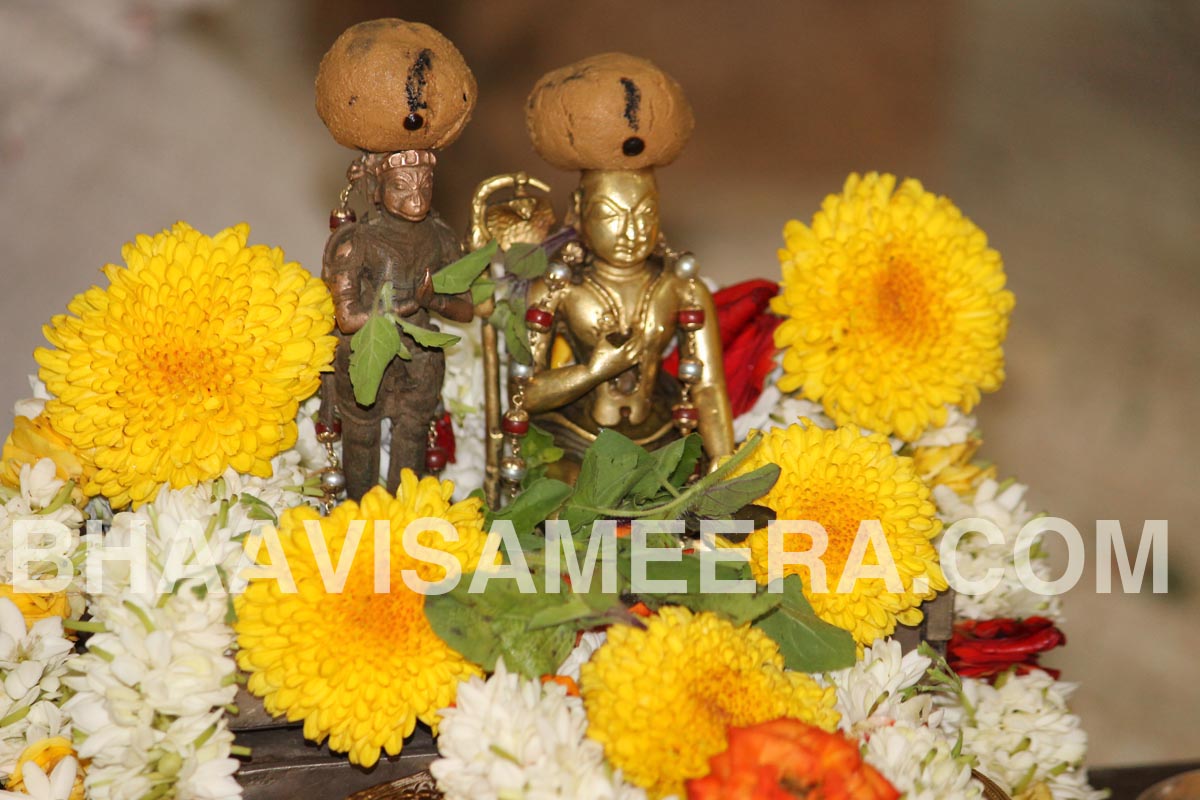Life History
Birth of Sri Vadiraja Teertharu

Dakshina Kannada, a place where nature is there in all its glory. Serene mountains, calm rivers and dense forests all make up for a perfect setting for ascetics. It is here at Gautama Kshetra is Kumbhasi. Kumbhasi is also reputed to be one of the seven kshetras of Bhargava Bhumi. Near Kumbhasi is a village Huvvinakere. In this village were a pious couple – Ramacharya and Saraswati (or Gowri). Leading an exemplary varnashrama dharma life, the couple were craving for a male progeny.
Sri Vageesha Tirtha, was the 19th pontiff of the then Kumbhasi Mutt. It is believed that he was a trikalajnani. He was from the lineage of Sri VishnuTirtha – who was the borther of Sri Madhvacharya. One night, in his dreams, he was told by Lord Bhuvarahaswamy ” A brahmin couple seeking birth of a son will approach you. Bless them and grant them phala manthrakshathe. They will soon have a very distinguished son. Make them promise to deliver this child to your care”. Same night, Ramacharya was guided to seek the blessings of the Pontiff for the birth of a son.
The next day, while Sri Vageeshamuni was worshipping Lord Bhoovaraha, Gowridevi prayed for a worthy son and promised to offer the Lord Lakshabharana. While the final mangalarthi was being offered to the Lord, a flower fell from the right side of Lord Hayagreeva. Vageeshamuni immediately realised that it was meant for the Ramacharya couple, blessed them saying that their wish for a son would soon be fulfilled. Though the couple were very happy to hear this, they were also a little worried after Vageeshamuni said that their son, being a jeevottama should be handed over to the mutt. Shri Vageeshamuni, later pacified the couple saying that if the child was born inside the house they could keep it, but if it were to be born outside the house, they would have to hand it over to the mutt.
Saraswati Devi soon became pregnant and the couple were joyful. She spent her time in pilgrimage, listening to puranas, visiting various temples and specially praying to Lord Bhuvaraha. With the progress of her pregnancy, Saraswati Devi became especially bright – foretelling the birth of a very gifted and enlightened child. Not willing to hand over the child to anyone, the couple took great care to spend as much time indoors. Man’s plans are wasted if God doesnt will so. It was a sadhana dwadashi day. Ramacharya was doing parane. A cow with its calf started eating from his ripe crop. Gowri Devi rushed to chase the cow which went far away and no one saw it ever.
The day had come and she was outside the house. Pre-empting this, Vageeshamuni had arrived with a palki, god harivana and maids to assist Gowridevi. According to Shri Hari’s plans, she gave birth to a son. Ruju Latavya was thus born in a gold harivana on a Wednesday, Magha Shudda Dvadashi in the year Sharvari 1402 (1480 AD).
Despite all care from the parents, as the Lord and fate had willed, the boy was born outside the house and thus was privileged to serve Sri Bhuvarahaswamy. When Sri Vageeshamuni picked up the newborn, the child lifted its folded hands to its head as though in prostration to the Swamiji. Ramacharya offered the boy to Vageeshamuni who empathised with the couple and suggested them to retain the boy till the age of five and to complete all the necessary Vaidika Samskaras. He also foretold of another male child and said that only after that would he give sanyasashrama to the child. He also suggested to name the child as Bhoovaraha.
Thus Latavya ruju was born as Bhoovaraha and the field where he was born acquired the name Gowri Gadde.





Childhood
It’s a sport of Gods that when they choose to be born as humans, they behave like them including, at times choosing to display their faults & their joys. Accordingly, BhoovarAha progressed in studies and other sports like any other child, alebiet his knowledge and devotional was alittle too much for a child of his age.
BhoovarAha’ gurupadesha, which could be described as a formality at best was done while he was three years old. Upanayana was performed at the age of five- which was supposedly watched by many devatas unseen to these human eyes.
One day, while the young BhoovarAha was jokingly asked who was dearer to him-father or mother, he nonchalantly answered like an ascetic : “Shri BhoovarAha worshipped by Vageeshamuni is dearest to me”. This reminded his parents of their promise to the sage. The same day, Vageeshamuni sent word. The young lad, BhoovarAha convinced his parents who were a litlle apprehensive in sending their young kid to the sage, saying that the fortune to serve Lord Sri BhoovarAha is gotten only after many births and should’nt be let go for mere worldy attachments. This was a boy of five speaking.
Ramacharya & Gauri went to Vageeshamuni’s ashrama with BhoovarAha and stayed with them.
Shrinivasacharya, a poorvashrama relative of Guru Vageeshamuni, who was later given ashrama, and was named Vidyanidhiteertha, was a learned vedanta scholar. Little Bhoovaraha was made his disciple. The little boy displayed detachment from worldly things from a very young age. Once, vAgIShamuni once wanting to test him asked his friends at the ashram to eat some delicious looking fruits kept for pooja without anybody’s notice. Little BhoovarAha refused it saying “You can hide from anyone’s sight but not from paramAtma who is all pervasive. ” One other time, his friends at the ashram wanted to go and watch bailAta, but little Varaha explained to them that if we they were to go to watch the bailAta, then they would find it difficult to get up early in the morning for the next days pAta and moreover as students they should concentrate only on acquiring knowledge and get distracted by other things. This maturity and control over senses marked him out for sanyAsatva.
Sanyasatva
It’s a sport of Gods that when they choose to be born as humans, they behave like them including, at times choosing to display their faults & their joys. Accordingly, BhoovarAha progressed in studies and other sports like any other child, alebiet his knowledge and devotional was alittle too much for a child of his age.
At an age of three, young BhoovarAha could write what was taught him to him the previous day without any help. upanayana was when he was five; an event watch by the Gods.
One day, while the young BhoovarAha was jokingly asked who was dearer to him-father or mother, he nonchalantly answered like an ascetic : “Shri BhoovarAha worshipped by Vageeshamuni is dearest to me”. This reminded his parents of their promise to the sage. The same day, Vageeshamuni sent word. The young lad, BhoovarAha convinced his parents who were a litlle apprehensive in sending their young kid to the sage, saying that the fortune to serve Lord Sri BhoovarAha is gotten only after many births and should’nt be let go for mere worldy attachments. This was a boy of five speaking.
Ramacharya & Gauri went to Vageeshamuni’s ashrama with BhoovarAha and stayed with them.
Teertha Prabandha
Soon after taking sanyasatva, Rajaru, embarked on a teertha yatra. A one of it’s kind yatra, one that would go on to be the world’s first recorded ‘travelogue’.
Before leaving on his yatre, Rajaru took permission from his mother. On her insistance, he also gave her a vigraha of himself, which even till date is worshipped at the mutt.
Starting from Udupi, Vadiraja covered West India(Pushkar), Norther India(Badari), East India(Kumbhakona) and South India(Ananthashayana). Mere reading of his grantha – Teertha Prabandhana grants one immense punya.
More on his momentous grantha here.
Lakshmi Shobhane
One night, Sridevi appeared in front of Vadiraja and asked him to sing the mangala of her wedding with SriHari. Thus was born Lakshmi Shobhane.
The next day, there was a wedding in the town wherein the bride collapsed suddenly at the alter of fire after being bitten by a snake which was in his head gear. Qualified doctors tried their bit, garuda mantra upaasakaru were tried, all but in vain. News of our great guru being in the same vicinity prompted them to imlpore upon Sri Vadirajaru to bring back/bless the bride groom.
While sprinkling teertha on the body of the collapsed bride groom, Lakshmi Shobhane was sung by Rajaru and lo and behold , by the end of it, the bride groom was back to normal.
Lakshmi Shobhane,which is all about Vishnu Sarvottamatva is beautiful to listen to. It gives joy to both the singer and the listener and increases Ole bhagya to all the ladies who recite this regularly with bhakti.
shObhAnavEnnirE surarOLu shubhaganige
shObhAnavEnni suGuNanigE |
shObhAnavEnnirE trivikramarAyagE
shObhAnavEnni suraprIyagE || shObhAnE ||
More on this great kAvya here.
The childless couple
There was a rich jahagirdar who being childless approached ShriVadirajaru and haughtily promised him riches if he blessed him with a son. Rajaru told him that he would remain childless and he should instead start charity and that is the way for him to reach superior world. The rich man was displeased. He later came across a mantrik, who gave the couple an apple to eat. Shortly a son was born. Greatly pleased with him, the rich jahagirdar rained riches on the unholy man.
After a few years when Sri Vadirajaru returned to that town, the jahagirdar out of contempt went to him and told him of his son and the mantrik. Rajaru summoned the child. When teertha was sprinkled on the child, it turned into a frightening ghost. It narrated the whole story. It belonged to a bhootagana who was held under the cast of the mantrik who had instructed him to be at the jahagirdar’s house for six years and later return to him after killing them both. Hearing this, the jahagirdar’s eyes opened and prostrated before the great Sri Vadirajaru.
Lakshalankara
When Sri Vadirajaru camped at Prayaga, Lord Sri VedaVyasa instruced him to compose a teeka for all the difficult words in Mahabharata. The same Sri vedavyasaru had earlier instructed Sri Madhvacharya to compose the Mahabharata Tatparya Nirnaya. Here He told him of his mothers promise of gifting a laksha alankara to the Lord while he was still a young child. Vedavyasaru invited him to visit Uttara Badri. There Sri Rajaru had the darshan of Vaishampayana and Acharya Sri Madhva amongst others.
Sri Vadirajaru then composed the Lakshalankara Teeka and offered it at the feet of the Lord. The same night, Gowridevi(his mother) dreamt that her son was offering a laksha alankara to Sri Bhoovaraha.
After his return from Badari, he camped on the banks of the river Varada and it was there that he composed another work of his, Pashandamatha Khandana – where in he rejects improper doctrines and preaches satshastra.
Pacche Vittala
A Jain king of the Banga Dynasty invited Sri Vadirajaru(to see his rich possessions) while he was camping at Moodbidre – a popular Jain pilgrimage center. Rajaru flatly refused to come to the temple. On being furthered caoxed, he contended but on a condition that if the idol in his possessions turns out to be of his God, the Jain King would have to hand it over to him. The King assuming that an already sculpted idol cant change shape anyway, readily agreed.
As soon as Sri Vadirajaru approached and stood at the temple entrance the idol carved out of precious stones, lifted its hand rested it on its waist. It turned into a bhanga which is reminscent of Lord Vittala. Indeed, the stone had turned into a Vittala Vigraha. The king was amazed and happily gave it to Gururaja.
The Paryaya System
As soon as Sri Vadirajaru returned from Badarikashrama, he changed the existing Paryaya System. Till then, yatis were following the paryaya system set in place by Sri Madhvacharya. Shri Vadiraja who is of the same ‘cadre’ as Shri Madhvacharya, in consultation with other ashta mutt yatis, elaborated the paryaya system to two years from the existing two months.
Rukmineeshavijaya
Great Scholars at Punyanagari(now Pune) were contemplating to declare Magha’s ‘Shishupalavadha’ as the best mahakavya of the time. Around the same time, Sri Vadiraja was camping in the city. Some vaishnava brahmins requested him to compose a kavya which would excelin its purity and uniqueness.
For the next ninteen days, while putting on gandha and akshate, Sri Vadiraja composed a beautiful kavya about Krishnavatara up to Rukmini Swayamvara. When the brahmins presented this work in front of other great scholars on the twentieth day, they were floored by the greatness of Sri Vadiraja’s composition. It was unanimously proclaimed to be the best mahakavya and Sri Vadiraja was declared with the title of kavikulatilaka.
On the instructions of Apayya Dixit(an Advatin Scholar), the mahakavya was taken in procession on an elephant. It is said that this great composition is even worshipped by Rudra, Indra and other devatas – what then to speak of it’s merits if worshipped by mortal humans!
Sri Vadiraja has chosen to indirectly reveal his identity in this grantha. Many shlokas are known to speak of his rujutva and of his previous birth as the brahmin who carried Rukmini Devis message to Sri Krishna.
Rameshwara & Kumbhakona
There is a mention Sri Vadirajaru once while at Rameshwara, having taken his customary dip at the sethu, wanted to visit Lanka and meet Vibhishana. Then, it was hinted that in the future he would do a similar act while in the avatara of Sri Hanuman and so need not do so now.
He then proceeded to Kumbhakona which was home to great scholars proficient in all shastras. A long drawn arguement based on tarka, vyakarna, chandas, jyotish shastra, meemaamsa and kavya was held. And Sri Vadiraja, just like Sri Madhvacharya(on the banks of Godavari) defeated them all and proved once again that he was a sarvajna.
Hayagreeva idol
A Daivajna Brahmin(one who excels in Shilpa Shastra-making idols of Gods/Deities for temples etc) wanted to make an idol of Sri Ganesha. After pouring panchaloha into the mould and making the idol, he attempted to take the idol out of the mould and was shocked to see that inside of the Ganesha mould, lay a Hayagreeva idol. Deciding to handle the issue later, he set it aside. Even after a few days, the idol was as hot as before. The Brahmin was then instructed in his dream to hand over the idol to a yati who would come to him the next day.
At the same time, Sri Vaidraja was camping in the vicinity and was similarly instructed by the Lord to accept his Hayagreeva idol and to perfom external pooja to the idol. Sri Vadiraja approached the Daivajna Brahmin and accepted the Hayagreeva idol from him.
From that day on, Sri Vadiraja would dutifully do pooja to the idol and offer hayagreeva(gram-jaggery preparation) as naivedya. The Lord bound by Vadirajas supreme devotion, would take the form of a resplendent white horse, approach Sri Vadiraja, while he held the naivedya on his head, going behind Vadiraja put His front legs on Vadiraja’s shoulders and accept the naivedya. To this day, this idol is worshipped as moola vigraha in the samsthana.
Jangama
Further down, villagers were being mesmerised by a jangama who would prove Lingadhari’s doctrines as superior by promising the villagers that he would make them have darshana of Eswara. Followers of other sects were being tortured and they approached Sri Vadiraja who decided to help. Along with Narayana Bhootaraja, Sri Vadiraja came to the place where the jangama was camping. All the bhootas under his control ran away on seeing Narayana Bhootaraja. He was rendered powerless. And so his game ended.
Thus Sri Vadiraja protected his devotees.
Krishnadevaraya
Krishnadevaraya ,the then emperor of Vijayanagara Empire, approached Sri Vadiraja. He was worried about his depleting coffers and fear of an impending attack by his enemies. Vadirajaru assured him of help and led him to a place full of rocks. This was Vali’s cave. He then retrieved from the cave some of Valis riches by sprinkling water on a rock which began to crack and reveal a box full of gold coins. The king, elated offered all the riches to Rajaru who refused and accepted two idols found in the cave, both of which are being worshipped till date daily during samsthana pooja by swamiji. One was Vittal vigraha and the other was Rama vigraha.
Krishnadevaraya was then invited by Sri Vadirajaru to Udupi during his paryaya. As he passed away, his brother Achutadevaraya visited Udupi and placed even more riches at his feet. Rajaru then got some renovation work done for Ananteshwara, Chandramoulishwara and Krishna Mutt.
